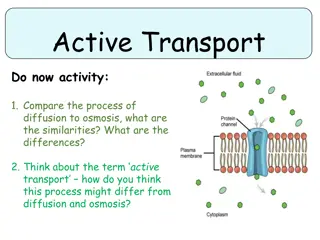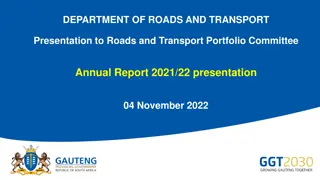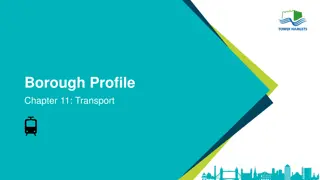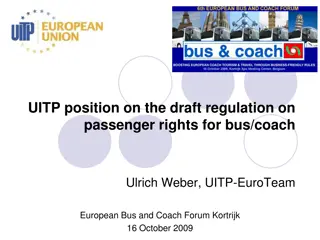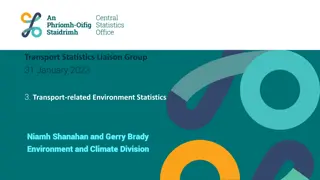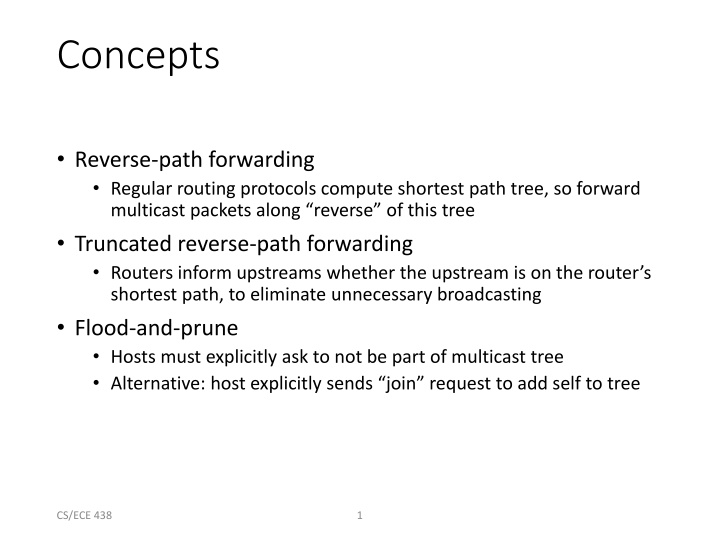
Reverse-Path Forwarding in Computer Networks
Explore the concepts of reverse-path forwarding, regular routing protocols, and multicast tree computation. Learn about truncated reverse-path forwarding and its elimination of unnecessary broadcasting. Discover the role of routers in informing upstream paths and the significance of explicit group joining in packet forwarding. Delve into the Transport Layer and the importance of end-host communication through the application layer.
Uploaded on | 2 Views
Download Presentation

Please find below an Image/Link to download the presentation.
The content on the website is provided AS IS for your information and personal use only. It may not be sold, licensed, or shared on other websites without obtaining consent from the author. If you encounter any issues during the download, it is possible that the publisher has removed the file from their server.
You are allowed to download the files provided on this website for personal or commercial use, subject to the condition that they are used lawfully. All files are the property of their respective owners.
The content on the website is provided AS IS for your information and personal use only. It may not be sold, licensed, or shared on other websites without obtaining consent from the author.
E N D
Presentation Transcript
Concepts Reverse-path forwarding Regular routing protocols compute shortest path tree, so forward multicast packets along reverse of this tree Truncated reverse-path forwarding Routers inform upstreams whether the upstream is on the router s shortest path, to eliminate unnecessary broadcasting Flood-and-prune Hosts must explicitly ask to not be part of multicast tree Alternative: host explicitly sends join request to add self to tree CS/ECE 438 1
Reverse-path forwarding Extension to DV routing Packet forwarding If incoming link is shortest path to source Send on all links except incoming Packets always take shortest path Assuming delay is symmetric Issues Routers/LANs may receive multiple copies CS/ECE 438 2
Truncated reverse-path forwarding Eliminate unnecessary forwarding Routers inform upstreams if used on shortest path Explicit group joining per- LAN Packet forwarding If not a leaf router, or have members Then send out all links except incoming CS/ECE 438 3
Transport Layer CS/ECE 438: Spring 2014 Instructor: Matthew Caesar http://courses.engr.illinois.edu/cs438/
From Lecture#3: Transport Layer Layer at end-hosts, between the application and network layer Application Application Transport Network Datalink Physical Transport Network Datalink Physical Network Datalink Physical Router Host B Host A
Why a transport layer? IP packets are addressed to a host but end-to-end communication is between application processes at hosts Need a way to decide which packets go to which applications (multiplexing/demultiplexing)
Why a transport layer? Application Application Transport Network Datalink Physical Transport Network Datalink Physical Host B Host A
Why a transport layer? many application processes browser browser mmedia telnet ftp Application Transport Network Datalink Physical Operating System IP Datalink Physical Drivers +NIC Host B Host A
Why a transport layer? many application processes Communication between processes at hosts browser browser mmedia server telnet telnet HTTP ftp ftp Transport Transport IP IP Datalink Physical Datalink Physical Communication between hosts (128.4.5.6 162.99.7.56) Host B Host A
Why a transport layer? IP packets are addressed to a host but end-to-end communication is between application processes at hosts Need a way to decide which packets go to which applications (mux/demux) IP provides a weak service model (best-effort) Packets can be corrupted, delayed, dropped, reordered, duplicated No guidance on how much traffic to send and when Dealing with this is tedious for application developers
Role of the Transport Layer Communication between application processes Mux and demux from/to application processes Implemented using ports
Role of the Transport Layer Communication between application processes Provide common end-to-end services for app layer [optional] Reliable, in-order data delivery Well-paced data delivery too fast may overwhelm the network too slow is not efficient
Role of the Transport Layer Communication between processes Provide common end-to-end services for app layer [optional] TCP and UDP are the common transport protocols also SCTP, MTCP, SST, RDP, DCCP,
Role of the Transport Layer Communication between processes Provide common end-to-end services for app layer [optional] TCP and UDP are the common transport protocols UDP is a minimalist, no-frills transport protocol only provides mux/demux capabilities
Role of the Transport Layer Communication between processes Provide common end-to-end services for app layer [optional] TCP and UDP are the common transport protocols UDP is a minimalist, no-frills transport protocol TCP is the whole-hog protocol offers apps a reliable, in-order, bytestream abstraction with congestion control but no performance guarantees (delay, bw, etc.)
Role of the Transport Layer Communication between processes mux/demux from and to application processes implemented using ports
Context: Applications and Sockets Socket: software abstraction by which an application process exchanges network messages with the (transport layer in the) operating system socketID = socket( , socket.TYPE) socketID.sendto(message, ) socketID.recvfrom( ) will cover in detail after midterm Two important types of sockets UDP socket: TYPE is SOCK_DGRAM TCP socket: TYPE is SOCK_STREAM
Ports Problem: deciding which app (socket) gets which packets Solution: port as a transport layer identifier 16 bit identifier OS stores mapping between sockets and ports a packet carries a source and destination port number in its transport layer header For UDP ports (SOCK_DGRAM) OS stores (local port, local IP address) socket For TCP ports (SOCK_STREAM) OS stores (local port, local IP, remote port, remote IP) socket
4-bit Header Length 8-bit 4-bit Version 16-bit Total Length (Bytes) Type of Service (TOS) 3-bit Flags 16-bit Identification 13-bit Fragment Offset 8-bit Time to Live (TTL) 8-bit Protocol 16-bit Header Checksum 32-bit Source IP Address 32-bit Destination IP Address Options (if any) Payload
8-bit 5 4 16-bit Total Length (Bytes) Type of Service (TOS) 3-bit Flags 16-bit Identification 13-bit Fragment Offset 8-bit Time to Live (TTL) 8-bit Protocol 16-bit Header Checksum 32-bit Source IP Address 32-bit Destination IP Address Payload
8-bit 5 4 16-bit Total Length (Bytes) Type of Service (TOS) 3-bit Flags 16-bit Identification 13-bit Fragment Offset 8-bit Time to Live (TTL) 6 = TCP 17 = UDP 16-bit Header Checksum 32-bit Source IP Address 32-bit Destination IP Address Payload
8-bit 5 4 16-bit Total Length (Bytes) Type of Service (TOS) 3-bit Flags 16-bit Identification 13-bit Fragment Offset 8-bit Time to Live (TTL) 6 = TCP 17 = UDP 16-bit Header Checksum 32-bit Source IP Address 32-bit Destination IP Address 16-bit Source Port 16-bit Destination Port More transport header fields . Payload
Recap: Multiplexing and Demultiplexing Host receives IP packets Each IP header has source and destination IP address Each Transport Layer header has source and destination port number Host uses IP addresses and port numbers to direct the message to appropriate socket
More on Ports Separate 16-bit port address space for UDP and TCP Well known ports(0-1023): everyone agrees which services run on these ports e.g., ssh:22, http:80 helps client know server s port Ephemeral ports (most 1024-65535): given to clients
UDP: User Datagram Protocol Lightweight communication between processes Avoid overhead and delays of ordered, reliable delivery UDP described in RFC 768 (1980!) Destination IP address and port to support demultiplexing Optional error checking on the packet contents (checksum field = 0 means don t verify checksum ) SRC port DST port checksum length DATA
Why a transport layer? IP packets are addressed to a host but end-to-end communication is between application processes at hosts Need a way to decide which packets go to which applications (mux/demux) IP provides a weak service model (best-effort) Packets can be corrupted, delayed, dropped, reordered, duplicated
Reliable Transport In a perfect world, reliable transport is easy @Sender send packets @Receiver wait for packets
Reliable Transport In a perfect world, reliable transport is easy All the bad things best-effort can do a packet is corrupted (bit errors) a packet is lost a packet is delayed (why?) packets are reordered (why?) a packet is duplicated (why?)
Dealing with Packet Corruption 1 ack 2 nack . . . 2 Sender Receiver Time
Dealing with Packet Corruption 1 1 Packet #1 or #2? 2 Sender Data and ACK packets carry sequence numbers What if the ACK/NACK is corrupted? Receiver Time
Dealing with Packet Loss 1 Timeout 1 Sender Set timer when packet is sent; retransmit on timeout Receiver Timer-driven loss detection Time
Dealing with Packet Loss 1 Timeout 1 duplicate! Sender Receiver Time
Dealing with Packet Loss 1 Timeout 1 . . . duplicate! Sender Timer-driven retx. can lead to duplicates Receiver Time
Components of a solution (so far) checksums (to detect bit errors) timers (to detect loss) acknowledgements (positive or negative) sequence numbers (to deal with duplicates)
A Solution: Stop and Wait @Sender @Receiver send packet(I); (re)set timer; wait for ack wait for packet if packet is OK, send ACK If (ACK) else, send NACK I++; repeat repeat If (NACK or TIMEOUT) repeat We have a correct reliable transport protocol! Probably the world s most inefficient one
Stop & Wait is Inefficient TRANS DATA RTT Inefficient if TRANS << RTT ACK 37 Receiver Sender
Sliding Window window = set of adjacent sequence numbers The size of the set is the window size; assume window size is n General idea: send up to n packets at a time Sender can send packets in its window Receiver can accept packets in its window Window of acceptable packets slides on successful reception/acknowledgement
Sliding Window Let A be the last ack d packet of sender without gap; then window of sender = {A+1, A+2, , A+n} n Already ACK d A Sent but not ACK d Cannot be sent sequence number Let B be the last received packet without gap by receiver, then window of receiver = {B+1, , B+n}n B Received and ACK d Acceptable but not yet received Cannot be received
Acknowledgements w/ Sliding Window Two common options cumulative ACKs: ACK carries next in-order sequence number that the receiver expects
Cumulative Acknowledgements (1) At receiver Received and ACK d n B Acceptable but not yet received Cannot be received After receiving B+1, B+2 n Bnew= B+2 Receiver sends ACK(Bnew+1)
Cumulative Acknowledgements (2) At receiver Received and ACK d n B Acceptable but not yet received Cannot be received After receiving B+4, B+5 n B Receiver sends ACK(B+1)
Acknowledgements w/ Sliding Window Two common options cumulative ACKs: ACK carries next in-order sequence number the receiver expects selective ACKs: ACK individually acknowledges correctly received packets Selective ACKs offer more precise information but require more complicated book-keeping
Sliding Window Protocols Two canonical approaches Go-Back-N Selective Repeat Many variants that differ in implementation details
Go-Back-N (GBN) Sender transmits up to n unacknowledged packets Receiver only accepts packets in order discards out-of-order packets (i.e., packets other than B+1) Receiver uses cumulative acknowledgements i.e., sequence# in ACK = next expected in-order sequence# Sender sets timer for 1st outstanding ack (A+1) If timeout, retransmit A+1, , A+n
Sliding Window with GBN Let A be the last ack d packet of sender without gap; then window of sender = {A+1, A+2, , A+n} n Already ACK d A Sent but not ACK d Cannot be sent sequence number Let B be the last received packet without gap by receiver, then window of receiver = {B+1, , B+n} n B Received and ACK d Acceptable but not yet received Cannot be received
GBN Example w/o Errors Sender Window Window size = 3 packets Receiver Window {1} 1 2 3 {1, 2} {1, 2, 3} {2, 3, 4} {3, 4, 5} {4, 5, 6} 4 5 6 . . . . . . Sender Receiver Time
GBN Example with Errors Window size = 3 packets 1 2 3 4 5 6 Timeout Packet 4 4 5 6 Sender Receiver
Selective Repeat (SR) Sender: transmit up to n unacknowledged packets Assume packet k is lost, k+1 is not Receiver: indicates packet k+1 correctly received Sender: retransmit only packet k on timeout Efficient in retransmissions but complex book-keeping need a timer per packet
SR Example with Errors Window size = 3 packets {1} 1 2 3 {1, 2} {1, 2, 3} {2, 3, 4} {3, 4, 5} {4, 5, 6} Packet 4 4 5 6 Timeout {4,5,6} {4,5,6} 4 Time {7, 8, 9} 7 Sender Receiver







